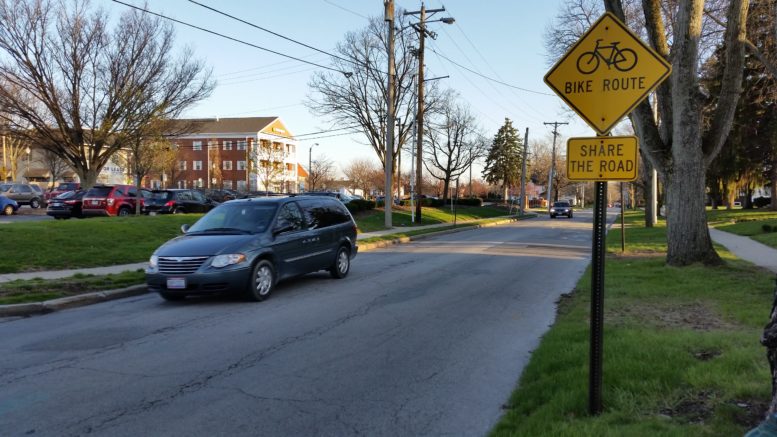By JAN LARSON McLAUGHLIN
BG Independent News
Rick Busselle is tired of getting no respect – and not enough space – from some motorists in Bowling Green. He carries a 3-foot stick on the handlebar of his bike – as a reminder to motor vehicle drivers that Ohio requires that they give at least 3 feet of space between their cars and bicycles.
But even that isn’t enough to keep him safe, he told Bowling Green City Council last week. Busselle described being knocked off his bike by a car exiting the high school parking lot.
“They didn’t see me until they heard my body hit their car,” he said.
Busselle, who rides his bike daily to work at BGSU, said he has been run off of Fairview Avenue twice, which has sharrows painted on the pavement to remind motorists to share the road. In both cases the cars swung wide of his bike, but then came back into his lane of travel when they met vehicles coming the opposite direction. Another time, the car from the opposite direction was forced off into the golf course.
“I don’t think there’s much awareness,” Busselle said.
In two other instances, a semi-truck and a school bus scraped the stick extending from his handlebar.
“It’s like it’s the bicycle’s job to stay out of the way,” he said.
Under Ohio law, bicycles are defined as “vehicles.” State law allows bicycles to be lawfully operated on virtually all Ohio roads except freeways or certain limited access roadways.
Cyclists are required to follow the basic rules of the road when riding on a roadway. Like any vehicle operator, a bicyclist must ride with traffic, obey basic traffic laws, stop at stop signs and red lights, and follow all traffic control devices. When following the rules of the road, a cyclist has exactly the same “right of way” as any motorist.
In 2017, Ohio joined a majority of states that require motorists passing cyclists on the road to allow a cushion of safety during the passing maneuver. Motorists must allow at least 3 feet of space between the motor vehicle and the bicycle being passed.
While most local motorists accommodate bicyclists, there is a small percentage who make it tough for cyclists, Busselle said.
“They just don’t think we belong here,” he said.
While at least one local bicyclist has carried a swimming pool “noodle” on his handlebars as a reminder to motorists, Busselle said the squishy foam turned out to be ineffective in keeping cars from crowding bicycles.
“They don’t care about those. They know they’re big and soft,” he said of motorists who ignore the 3-foot rule.
Busselle was joined at last week’s council meeting by two other bicyclists – Kurt Panter and Ann Beck – who shared their stories of close calls with cars and rude shouts from motorists in Bowling Green.
“There are people in this town who bike for transportation,” Beck said, explaining that she is often yelled at by motorists as she rides on city streets. “We’re here. We are silent. We don’t say anything.”
When riding home on West Poe Road after last week’s City Council meeting, Busselle reported that a motorist yelled at him to “get off the F-ing road.”
“I’ve only been hit once, which I feel fortunate about,” he said.
Busselle suggested that the city has put a lot of effort into educating bicyclists about their responsibilities – but not enough into educating motorists about the laws requiring them to share the road.
“If there are no bike lanes, the drivers feel we don’t belong there,” he said. “We need to educate car drivers to just treat us like other cars.”
Busselle moved back to the Bowling Green area about 10 years ago after living in an area that had designated bike lanes to encourage bicycling. He soon noticed that as local streets were repaved, bike lanes were not being added.
“It’s a matter of will,” he said, using Fairview Avenue as an example of a missed opportunity for a bike lane. “Nobody was willing to give up 4 feet of the golf course” for a bike lane.
“Do you want to move into the 21st century – or do we want to remain car-centric?”
Busselle said some of his BGSU students have told him they don’t feel safe riding bikes in town.
“We’re teaching our kids it’s really not safe to ride, and that’s a terrible thing,” he said.
Bowling Green Police Major Justin White said local motorists need to pay attention and be aware of bicyclists’ rights.
“They do have a right to be on the roadway,” he said.
White suggested that bicyclists who have to swerve off the roadway or who collide with motorists who refuse to give the required three feet of space, should contact the police and provide the license plate of the vehicle if possible.

Also at Monday’s meeting, Mayor Mike Aspacher and Steve Langendorfer, head of the city’s Bicycle Safety Commission, recognized the city’s “Bike Spokesperson of the Year.” Don DiBartolomeo, founder of the non-profit “The Right Direction” organization, was selected for his advocacy for cycling.
“This year we really hit the jackpot,” Langendorfer said of DiBartolomeo. “Don is a noted figure in bicycling.”
Each year, all Bowling Green third graders are invited to the skate/bike park in City Park, where DiBartolomeo and fellow cyclists promote bicycling.
“We are very proud for the 2022 Bike Spokesperson to be Don DiBartolomeo,” Aspacher said.
In other action at Monday’s City Council meeting, Aspacher announced the newly appointed members of the city’s Climate Action Plan Committee. They include city officials Joe Fawcett, Amanda Gamby, Mick Murray and Jim Odneal, as well as Nick Hennessey of BGSU’s sustainability office, Kati Thompson of Bowling Green’s economic development office, Marissa Bechstein of TMACOG, Tyler Williams of Southeastern Container, and Jim Evans a retired BGSU geology professor.
“We look forward to beginning the process,” Aspacher said of the climate action plan effort.

